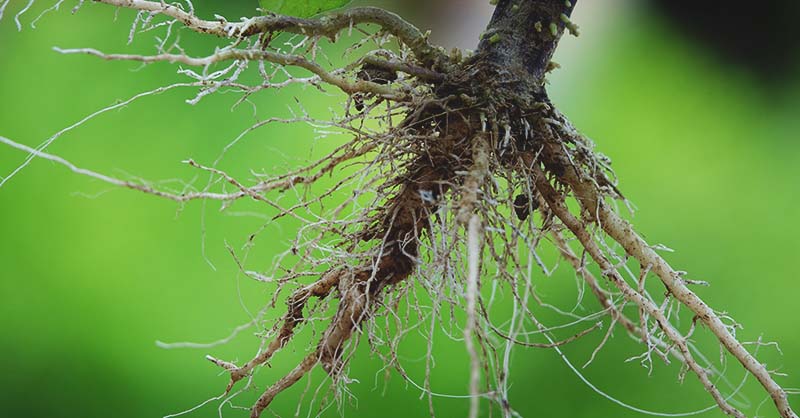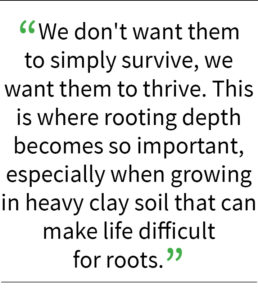Learn about each plant’s rooting depth and width

By Kate Russell

Kate Russell
Have you ever wondered how deep plant roots grow in your Morgan Hill garden?
We’ve all seen examples of tenacious, wind-battered trees growing impossibly out of rocks, but we want life for our garden plants to be better than that, don’t we? We don’t want them to simply survive, we want them to thrive. This is where rooting depth becomes so important, especially when growing in heavy clay soil that can make life difficult for roots.
How deep plant roots go depends on several variables: species, plant size and age, soil structure, soil health, soil moisture levels, and many other factors.
Mulching compacted clay soil can help improve its friability over time, but knowing about rooting depth now can help you place plants where they can thrive.
 Shallow rooted plants are your best choices for containers, towers, and compacted soil. Basil, chives, cilantro, endive, escarole, ginger, lettuce, oregano, parsley, radish, scallions, spinach, summer savory, tarragon, and thyme can all be grown in less than 12 inches of soil. Of course, more is generally better. That unassuming lettuce plant may grow in shallow soil, but its roots can go down six inches or more, given time and opportunity.
Shallow rooted plants are your best choices for containers, towers, and compacted soil. Basil, chives, cilantro, endive, escarole, ginger, lettuce, oregano, parsley, radish, scallions, spinach, summer savory, tarragon, and thyme can all be grown in less than 12 inches of soil. Of course, more is generally better. That unassuming lettuce plant may grow in shallow soil, but its roots can go down six inches or more, given time and opportunity.
Slightly deeper growing plants, arugula, bok choy, celery, fennel, garlic, Jerusalem artichoke, mint, onions, rosemary, shallots, strawberries, and Swiss chard need at least 12 inches of soil but perform better in 18 inches or more. Moderately deep-rooted plants need at least 18 inches of soil to grow properly.
This group includes beans, beets, blueberries, broccoli, cabbage, carrots, chilies, collards, Brussels sprouts, cauliflower, cucumbers, eggplant, horseradish, kale, leeks, kohlrabi, mustard greens, Napa cabbage, okra, peas, peppers, potatoes, rutabagas, sweet potatoes, and turnips.
Artichokes, cantaloupe, cardoon, cereal grains, citrus, figs, lima beans, melons, parsnips, peaches, pumpkins, sage, squash, tomatoes, and watermelon need at least 24 inches of loose, nutrient-rich soil.
Asparagus, cherries, fava beans, hops, olives, pears, prunes, and rhubarb are deep-rooted plants that will ultimately go down three feet or more. Almonds, apricot, corn, and walnut may have roots that are five or more feet long. The roots under your grape vines may be 20 feet long.
If you have had bad luck with strawberry pots, it may be because those shallow-rooted strawberries can actually be three feet long. And a 10-year old horseradish plant may have 14 foot roots! And that lawn, its root system is pitiful compared to native prairie grasses and other native plants.
Roots spread out differently, too. Carrot roots go straight down while cucumbers may spread 2 feet in every direction. Before trying your hand at intercropping or container gardening, you should learn about each plant’s rooting depth and width.
Your Morgan Hill garden will grow bigger, healthier, and more productive plants.
Kate Russell is a UCCE Master Gardener in Santa Clara County. For more information, visit mgsantaclara.ucanr.edu or call (408) 282-3105 between 9:30 a.m. and 12:30 p.m., Monday through Friday. Be sure to stop by the Spring Garden Market from 9 a.m. to 2 p.m. April 18, at Martial Cottle Park for all of your spring planting needs.






